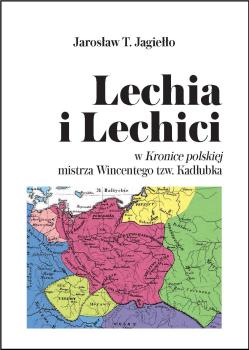Lechia i Lechici w Kronice polskiej mistrza Wincentego tzw. Kadłubka
Keywords:
Kadłubek, Lechia, Lechites, Master, WincentySynopsis
LECHIA AND LECHITES IN CHRONICA POLONUM BY MASTER WINCENTY, CALLED KADŁUBEK
This study is a monograph constituting return to research on Lechitic issues, abandoned after 1897. In the book, one can find the following parts: an introduction, four substantive chapters and conclusion.
The first chapter discusses a historical source constituting the subject matter of the study; its author and his perception of his book, work on it and his own personality.
In the second chapter, the analysis of ethnic nomenclature contained in the historical source has been presented. Because of this analysis, it is determined that double nomenclature of the same folk is not typical only for defining Poles in the discussed historical piece of literature. The regular, double nomenclature, captured in the presented source, that is of Germans („Lemans”, „Teutons”), Czechs („Czechs”, „Prażanie”) and Hungarians („Hungarians”, „Pannonians”), became the comparative background for double naming the ancestors of Poles as „Poles” and „Lechites”.
The third chapter presents all mentions contained in the discussed historical piece of literature and comprising terms included in the title of this study („Lechia”, „Lechites”). A detailed analysis of contextures in which they were inscribed has shown that master Wincenty depicted Lechites most often as troops – knights – and territorially associated them, most of all, with Krakow and the area of the upper Vistula basin, not with the other districts of Poland.
The fourth chapter presents the subsequent chronicles and elaborations – written after the work of master Wincenty – containing the title ethnic nomenclature. This analysis shows the creation of new levels in the Lechitic narration, together with the evolution of contents of the term „Lechites”.
In the conclusion, two complementary interpretations of the subject matter of this study have been formulated. The first interpretation, defined as descriptive and critical, presents conclusions resulting from the usage of the philological method in the analysis of fragments of Kronika polska. For creation of the strictly historical interpretation, other method, used in the historical science – namely genetic – was used.
Chapters
-
TABLE OF CONTENTS
-
Wstęp .......... 11
-
ROZDZIAŁ I. KRONIKA POLSKA I JEJ AUTOR .......... 31
-
1.1. Przyczyny powstania Kroniki .......... 32
-
1.2. Źródła wiedzy dziejopisarza .......... 33
-
1.3. Cele i zadania dziejopisarskie .......... 38
-
1.4. Użyteczność historii .......... 43
-
1.5. Metodologia Kroniki .......... 45
-
1.6. Kronikarz o sobie .......... 49
-
1.7. Zasady czytania Kroniki .......... 53
-
1.7.1. Problem niedoskonałości .......... 56
-
1.8. Ocena pracy kronikarza .......... 58
-
ROZDZIAŁ II. INNE ETNONIMY NIŻ LECHICI UŻYTE W KRONICE POLSKIEJ .......... 61
-
2.1. Polacy .......... 61
-
2.2. Pozostałe etnonimy .......... 70
-
2.3. Lemanie .......... 77
-
2.4. Czesi .......... 81
-
2.5. Węgrzy .......... 85
-
2.6. Podsumowanie .......... 90
-
ROZDZIAŁ III. LECHIA I LECHICI W KRONICE POLSKIEJ BISKUPA WINCENTEGO .......... 95
-
3.1. Księga I .......... 95
-
3.2. Księga III .......... 103
-
3.3. Księga IV .......... 110
-
3.4. Podsumowanie i konkluzja .......... 123
-
ROZDZIAŁ IV. LECHICI W HISTORIOGRAFII POLSKIEJ .......... 129
-
4.1. Chronica Polonorum, tj. Kronika polsko-śląska, powstała tuż po 1285 r. .......... 129
-
4.2. Chronica Polonorum (Chronica Dzirsvae), tj. Kronika Dzierzwy, powstała tuż po 1305 r. .......... 132
-
4.3. Kronika wielkopolska, ostatecznie zredagowana tuż po ok. 1375 r. .......... 136
-
4.4. Piotr z Byczyny, Chronica principum Poloniae, tj. Kronika książąt polskich, powstała tuż po 1382 r. .......... 148
-
4.5. Jan Długosz, Annales seu cronicae incliti Regni Poloniae, tj. Roczniki czyli kroniki sławnego Królestwa Polskiego, powstałe po 1455 r. .......... 152
-
4.6. Maciej z Miechowa, Chronica Polonorum, tj. Kronika polska, wydanie z 1521 r. .......... 159
-
4.7. Marcin Kromer, De origine et rebus gestis Polonorum libri XXX, tj. O pochodzeniu i czynach Polaków ksiąg XXX, 1555 r. .......... 164
-
4.8. Marcin Bielski, Kronika Polska Marcina Bielskiego nowo przez Ioach. Bielskiego syna iego wydana, 1597 r. .......... 168
-
4.9. Adam Naruszewicz, Historya Narodu Polskiego, t. 1, spisany przed 1780 r. .......... 173
-
4.10. Joachim Lelewel, Uwagi nad Mateuszem herbu Cholewa, polskim XII wieku dziejopisem, a w szczególności nad pierwszą dziejów jego księgą, 1811 r. .......... 174
-
4.11. Józef Ossoliński, Wiadomości historyczno-krytyczne do dziejów literatury polskiéy, 1819 r. .......... 178
-
4.12. Joachim Lelewel, Geografja. Opisanie krajów polskich, 1829 r. .......... 179
-
4.13. August Bielowski, Wstęp krytyczny do dziejów Polski, 1850 r. .......... 185
-
4.14. Wacław A. Maciejowski, Roczniki i kroniki polskie i litewskie najdawniejsze, 1850 r. .......... 187
-
4.15. Karol Szajnocha, Lechicki początek Polski, 1858 r. .......... 188
-
4.16. Wojciech Kętrzyński, Die Lygier. Ein Beitrag zur Urgeschichte der Westslawen und Germanen, 1868 r. .......... 189
-
4.17. Julian Bartoszewicz, Historja pierwotna Polski, 1878 r. .......... 194
-
4.18. Franciszek Piekosiński, O powstaniu społeczeństwa polskiego w wiekach średnich i jego pierwotnym ustroju, 1881 r. .......... 199
-
4.19. Wilhelm Bogusławski, Dzieje Słowiańszczyzny północno-zachodniej do połowy XIII w., t. 3, 1889 r. .......... 203
-
4.20. Antoni Małecki, Lechici w świetle historycznej krytyki, 1897 r. .......... 205
-
4.21. Karol Potkański, Lachowie i Lechici, 1897 r. .......... 209
-
4.22. Ernst A. Kunik, Lęchica. Pogląd krytyczny na dotychczasowe traktowanie kwestyi lechickiej, 1898 r. .......... 213
-
4.23. Jacek Banaszkiewicz, Polskie dzieje bajeczne mistrza Wincentego Kadłubka, 1998 r. .......... 225
-
4.24. Piotr Makuch, Od Ariów do Sarmatów. Nieznane 2500 lat historii Polaków, 2012 r. .......... 234
-
4.25. Andrzej Nowak, Dzieje Polski, t. 1: Do 1202 r. Skąd nasz ród, 2014 r. .......... 237
-
4.26. Paweł Żmudzki, Kulturowy kontekst nazw „Polanie”, „Polacy”, „Polska” w średniowiecznej historiografii polskiej i ruskiej, 2017 r. .......... 247
-
4.27. Wnioski .......... 248
-
ZAKOŃCZENIE .......... 251
-
BIBLIOGRAFIA .......... 293
-
SPIS TABEL, MAP I RYSUNKÓW .......... 303
-
INDEKS NAZWISK .......... 307





